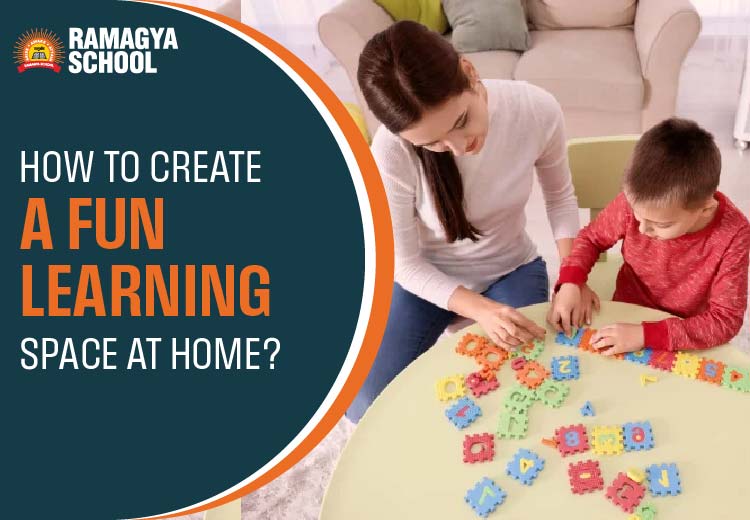Have you ever asked yourself – why does my child enjoy playtime more than study time? It’s just that traditional studying can sometimes feel boring or stressful. Finding a way to understand how to make learning fun is the major challenge here. When learning feels like play, children become excited, curious, and ready to explore!
That’s why creating a fun learning space at home is so important. It gives your child a happy corner to think, read, create, and grow.
Why Does a Fun Learning Space Matter?
Children need a calm, fun, and positive environment in order to stay engaged. If the environment is dirty and noisy or dull and boring, they might lose interest. However, if the area is colorful and neat, as well as exciting, learning is a joyous experience.
What makes learning fun?
- A bright and cheerful set-up
- Fun and exciting activities
- Space to move and make
- Applaud and show support
- There’s no pressure Just exploring
8 Steps to Make a Fun Learning Space at Home
- Find the Right Spot
Find a quiet area in your home, free of distractions such as loud music or televisions, as well as busy roads. It might be the corner in their bedroom, or a small portion of the living room or an area close to the window.
Why this matters: A calm, personal corner helps children concentrate better and gives them their own little “learning world” where they feel safe and relaxed.
Your child can help you pick the best space for them. If they’re part of the process of setting it up they’ll be satisfied and proud, as well as more eager to utilize it.
- Add Colors and Imagination
Use your child’s favorite colors to decorate their room. Put up posters of educational content with animals, alphabets and multiplication tables. Include a calendar, small whiteboard or blackboard and perhaps some fairy lights for the room to give a magical look.
Why this matters: Children are visual learners. Bright, fun visuals grab their attention and help them remember concepts better.
You could also put your own work to the walls. This boosts faith and can make the area feel like it truly belongs to them.
- Keep it Tidy and Easy to Use
Use baskets, boxes or trays to store pencils, books and other tools organized. Only keep the most essential items in this space to prevent confusion and mess.
Why this matters: A tidy area helps reduce stress and keeps the focus on learning, not searching for supplies.
Ask your child to clean up after learning. It helps build accountability and helps keep the area clean for the next session.
- Add Creative Tools and Learning Games
The area is filled with puzzles, blocks for building instructional games, picture books and flashcards. Change the items every week to keep it exciting and new.
Why this matters: Fun learning activities for kids like matching games or storytelling dice build memory, language, and thinking skills in an exciting way.
It is also possible to introduce DIY activities or science kits that transform your playtime into an effective learning experience.
- Make the Space Flexible
Most children don’t want to spend a lot of time at a desk all day. There should be a sofa, a mat or something to switch places to sit on. You can let them move between the floor and the desk according to their preferences.
Why this matters: Movement helps the brain stay active. It also allows kids to learn in a way that feels natural to them.
When they’re bored of sitting for too long,ask them to stand up or stretch out. It’s all part of an engaging and flexible learning pattern.
- Use Light and Nature
Let sunlight shine into the room if it is possible. Add a bouquet of flowers or a tiny potted plant to give the room a more inviting and modern atmosphere.
Why this matters: Good lighting improves mood and attention. Nature adds calmness and makes the space more inviting. It helps to learn with fun.
A small fishbowl, feather collection or leaf art may introduce nature into the realm of study.
- Create a Special Reading Zone
Create a small book corner with books and storybooks, comics or magazines for children. Add a comfortable rug, mat, or small table for reading.
Why this matters: Reading helps kids learn with fun, improve their vocabulary, and spark their imagination.
Just motivate them to read something quietly for at least fifteen minutes throughout the day. It is also possible to take turns reading aloud and discussing stories you want to read together.
- Celebrate Small Successes
Make a reward chart or a sticker board to recognize each time your child finishes the task, learns about something completely new, or assists in helping keep the room clean. Offer smiley faces, stars or just basic “Well Done!” notes.
Why this matters: Positive reinforcement builds confidence. With this they feel proud and motivated to learn more.
Also Read- How to Keep Kids Busy Without Screen Time?
Fun Learning Activities for Kids You Can Try at Home
- Alphabet Hunt: Place letters cards throughout the home. Have your child search for them and put them in a specific order.
- Number Hop: Write numbers on paper and place them on the floor. Say a number and let your child jump on it.
- Story Basket: Place 3 random items into a basket. Have your child create a story using these items.
- Shape Art: Make use of paper cutouts to create enjoyable characters using only triangles, circles and squares.
- DIY Weatherboard: Let your child keep updating the weather chart each day and discover about the seasons and temperatures.
These are all fun learning activities for kids that turn your home into a playful classroom.
Learn Fun and Have Fun, and Grow with confidence
Creating a learning space at home doesn’t need a big budget or lots of room. All it needs is your care, a little creativity, and your child’s excitement. Whether your child is solving a puzzle or reading under a cozy light, they’re learning every moment.
Remember, the goal is not to force study but to build a place where your child learns with fun every single day. That’s how you create a love for learning that lasts a lifetime.
So, get started today! Set up that joyful corner, add some colors and smiles–and watch how beautifully your child begins to grow.




